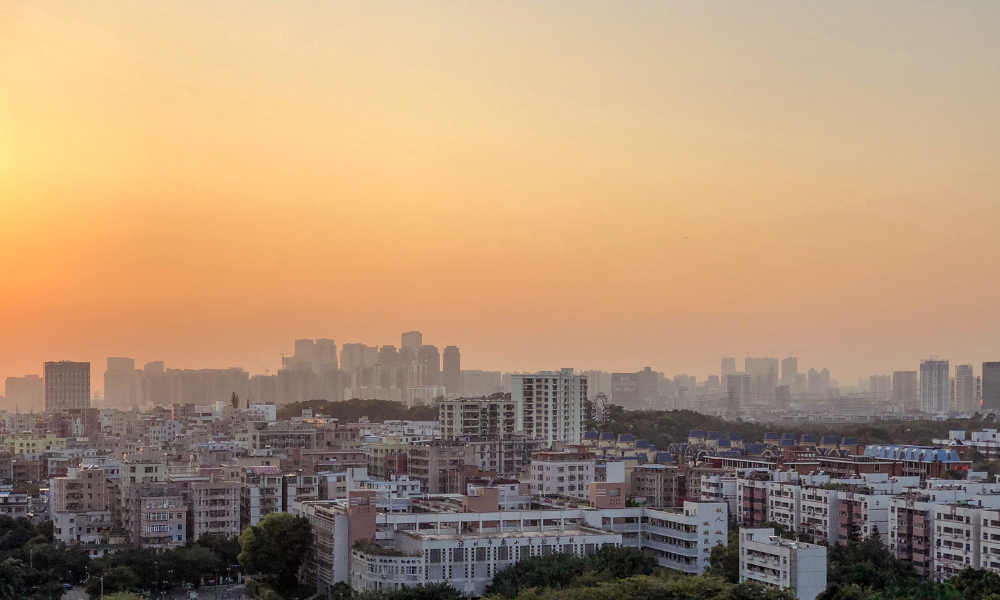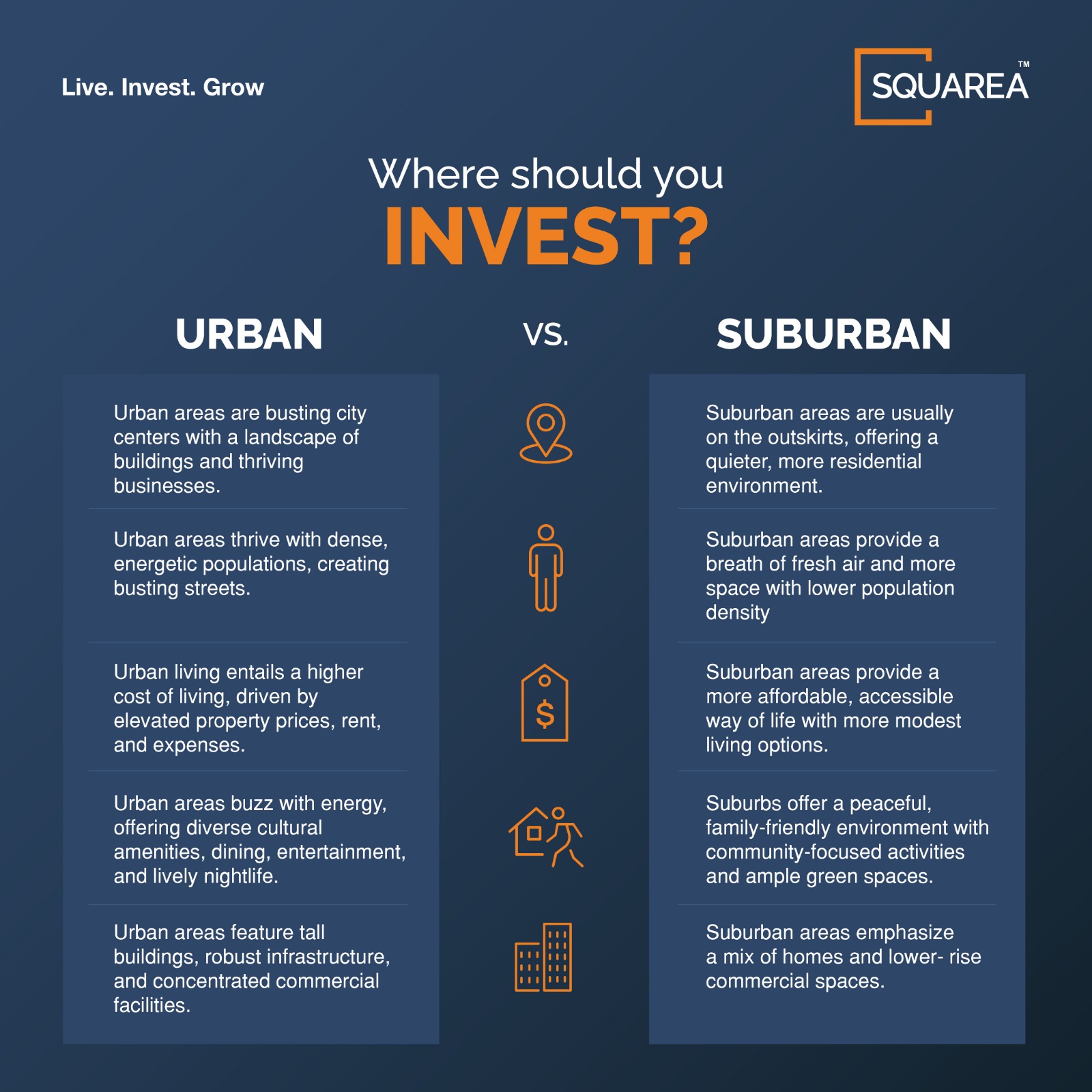
Great experience with this company,the job done by there subordinate are truly appreciated 👍

Great experience with this company,the job done by there subordinate are truly appreciated 👍

Investing in real estate is a pivotal decision, one that hinges significantly on the choice of location. Whether you are buying property for the first time or adding to your investment portfolio, the question often comes down to this: Should you invest in the vibrant heart of the city or explore the expansive suburban regions? In 2024, India's real estate landscape continues to evolve, with significant developments in both urban and suburban areas. In such a scenario, understanding the best real estate investment areas has become essential for both investors and homebuyers.
The Indian real estate sector is projected to reach an estimated value of $1.5 trillion by 2030, with a compound annual growth rate (CAGR) of about 9.2% from 2023 to 2028. The first half of 2024 saw a continued surge in residential sales, reaching 173,241 units, an impressive 11% year-on-year growth. This positive trend indicates a strong demand for housing in the market.
This blog delves into the key considerations, the pros and cons of each option, and the latest market insights to help you make a well-informed decision.
Before diving into detailed insights, it’s essential to understand the key factors that distinguish urban and suburban real estate investment areas:

Alt text: A comparative glance at the key differences between city and suburban real estate investments.
Urban centers across India remain hotspots for real estate investment due to high demand, robust infrastructure, and proximity to key amenities. Cities like Mumbai, Pune, Bengaluru, and Delhi are well-known for their vibrant job markets and advanced infrastructure, making them some of the best real estate investment areas.
1. High Demand and Fast Appreciation : Urban properties often see quicker appreciation. Mumbai's prime localities like Bandra and Powai saw an average price increase of 7-9% in 2023-2024 (Knight Frank India's Prime Residential Index). While in Pune, Koregaon Park has seen consistent appreciation of 6-8% annually, making them ideal for short-term investments in the best real estate investment areas.
2. Proximity to Amenities : Cities offer a wealth of amenities such as hospitals, schools, restaurants, and entertainment venues. Pune is renowned for its educational hubs, adding to its appeal as one of the best real estate investment areas in India.
3.Job Opportunities: Major cities house industries across sectors like IT, finance, and manufacturing. For instance, Pune’s IT hubs and tech parks attract a large workforce, making it a strong contender for real estate investment areas in India.
Public Transportation : Urban transport systems, like Mumbai’s local trains or Delhi’s metro, including Pune’s ongoing metro project, boost property values around transport hubs, solidifying their status as the best real estate investment areas.
Longer Commutes: Suburbs can be farther from major job centers, increasing travel time. However, with improved transport networks such as the Pune Metro Extension, connectivity to suburban areas is gradually improving.
Limited Social Infrastructure: While development is ongoing, many suburban areas still lack the robust social infrastructure found in cities. This can be a drawback for those who value proximity to shopping malls, entertainment centers, and restaurants.
In 2024, both urban and suburban markets in India are poised for growth, driven by government initiatives, economic recovery, and rising demand. Programs like PMAY and RERA have improved transparency, making suburban regions particularly appealing. The ARHC scheme also enhances suburban areas by providing affordable housing near industrial hubs. Meanwhile, smart city projects are revitalizing urban centers, boosting livability and sustainability.
Urban investments offer faster appreciation and proximity to job markets, while suburban areas provide affordability and space. Your choice depends on your financial goals and lifestyle preferences.
If you still find it difficult to decide, contacting a real estate expert like Squarea can help you navigate the complexities of property buying and investment in India.

Primary Keyword: Factors Affecting Property Prices in India
Secondary Keywords: Real Estate Market in India, Property Price Trends
Investing in real estate is a significant decision for homebuyers in India. Real estate constitutes an appreciable percentage of most people’s wealth. The real estate market in India is influenced by various dynamic factors that drive property price fluctuations. All these factors affecting property prices in India are very important for home buyers and investors to understand to navigate this complex scenario and make the right decisions. It attracts as well as creates huge opportunities for investors because of the size and scale of this real estate market.
In this article, we will discuss and analyze the main factors affecting property prices in India.
Experts predict moderate growth for the Indian real estate market. ICRA and Colliers suggest a shift from last year's rapid expansion to steadier progress. ICRA anticipates price stabilization, while Colliers highlights infrastructure projects and economic recovery as key drivers of resilience.
The seven major metros—Mumbai, Delhi NCR, Bangalore, Chennai, Pune, Hyderabad, and Kerala—are set to experience varied growth:
Mumbai: 5-8% rise, driven by metro expansion and coastal projects.
Bangalore & Hyderabad: Increases of 6-9% and 7-10%, respectively, due to the IT boom.
Chennai & Pune: Expected gains of 5-7% and 6-8%, aided by residential demand and metro expansions.
Kerala: 3-5% growth from NRI investments and tourism.
(Sources: CBRE India, JLL India, Colliers).The nexus between economic growth and property prices is well-established. India's real GDP expanded by 7.2% in FY23, the highest among major economies, fueling real estate demand. Q1 2024 saw record residential sales with 74,486 units sold, driven by large-scale projects, smart city initiatives, and urban renewal programs
Interest rates are a key determinant of property prices. Lower rates reduce borrowing costs, boosting demand, while higher rates may curb it. RBI's 2024-25 monetary policy aims to balance inflation and growth, shaping housing market trends accordingly.
Government policies directly impact the supply-demand curve of the real estate market in India. Policies like the Real Estate (Regulation and Development) Act (RERA), 2016 have increased transparency, boosting buyer confidence. The Pradhan Mantri Awas Yojana (PMAY) and GST reductions on under-construction properties enhance affordability, stimulating investments in new developments.
With 600 million people expected to live in cities by 2030 (40% of India’s population), housing demand is on a continuous rise. Bangalore, Hyderabad, and Pune are key beneficiaries, driven by industrial growth and skilled professional inflows.
The quality of infrastructure is another factor that determines values in properties. Areas well connected with transport, educational institutions, and health facilities attract a premium. Infrastructure projects like the Mumbai Trans Harbour Link and Bangalore's Namma Metro are expected to raise property prices by 20-30% in adjacent areas, highlighting the importance of connectivity for real estate appreciation.
The balance between housing supply and demand significantly impacts prices. In markets with high demand but limited supply, prices rise due to scarcity. Conversely, areas with abundant supply may experience stable or declining prices. For instance, the luxury housing segment in cities like Delhi NCR is seeing higher demand, driving prices up. In contrast, markets with substantial affordable housing inventory show more consistent rates.
Building material costs (steel, cement, labor) influence property prices. Developers often pass these increases to buyers, especially in high-cost cities like Mumbai, where land acquisition also inflates prices.
Job growth in IT and finance sectors, especially in Bangalore, Hyderabad, and Pune, increases housing demand. The Indian IT market is expected to reach $19.93 billion by 2025, further boosting residential real estate.
Industrial corridors like the Delhi-Mumbai and Chennai-Bangalore are enhancing property values in surrounding areas, supported by job creation and infrastructure improvements
Property price trends vary significantly across different regions, influenced by factors such as local economic activity, infrastructure development, and regulatory environment. Pune’s residential market claimed a substantial 16% of new residential launches across India’s top cities in Q2 2024 – adding around 18,900 units and marking a steady 1% quarterly increase.
Understanding the several factors affecting property prices in India is very important for home buyers and investors planning to invest in the real estate market in India. Staying informed about these factors is key to capitalizing on opportunities and navigating potential challenges.
For those looking to deepen their understanding and make informed decisions in this dynamic environment, consulting with experts in the field can be invaluable. SQUAREA offers insights that can help you navigate these complexities and align your investments with market trends.

In India, the concept of generational wealth has deep roots, traditionally built through assets like gold or inherited businesses. Real estate, often called a “brick-and-mortar bank,” isn’t just about owning a piece of land but creating a legacy. As family wealth continues to hold strong cultural significance, generational wealth through real estate offers Indian families a unique, resilient pathway for building assets that can be passed down across generations. Unlike more volatile investments, real estate brings stability, potential for appreciation, and tax advantages, making it a compelling choice for long-term wealth creation.
In this blog, let’s decode how generational wealth through real estate becomes a multi-generational asset and why it’s so effective for building lasting family wealth in India.
The answer is simple: real estate combines stability, value appreciation, and tangible security; qualities that are important and mandatory for long-term investments.
In India, the demand for property has consistently risen, fueled by rapid urbanization and a young, growing population. According to Forbes, real estate is “easily transferable through inheritance,” which is crucial for those looking to leave behind a stable, valuable asset. Real estate assets also tend to appreciate over time, offering both rental income and significant resale value.
Moreover, property ownership confers control. Owners can decide how to leverage their assets by either renting them out for steady cash flow, developing them, or selling them when the market peaks. The tangible security real estate offers is especially reassuring in emerging economies like India, where market volatility and currency fluctuations can impact other forms of wealth.
In fact, a study by Lumicre shows that real estate appreciates at an average of 5% annually, a rate that can compound to create substantial value over the decades. For families, this translates to an asset that can serve both as a safety net and a growth engine, a powerful combination that few investments can match.
Pune exemplifies India’s real estate potential for generational wealth. Once a quieter cousin to Mumbai, Pune has transformed into a bustling hub for IT, education, and manufacturing. The city’s rise has been a boon for early investors, whose properties have appreciated significantly over the last decade. Over the last ten years, property values in Pune have surged which is an impressive gain that has rewarded early investors handsomely.
Consider Magarpatta City, a unique, farmer-led real estate development that has transformed a community’s financial landscape. When a group of farmers pooled their lands to create this integrated township, they not only secured their financial future but also showcased how property development can create lasting wealth.
Today, Magarpatta is one of Pune’s most desirable areas, with thriving businesses and high-quality residential options. Magarpatta City’s development by a collective of farmers stands as an inspiring model, showcasing how land investments, when strategically developed, can multiply wealth across generations.
Real estate isn't just about growth, it’s about security, too. The Indian market is uniquely suited for multi-generational wealth, with property values bolstered by rising housing demand driven by urban migration and suburban expansion. Property ownership offers a level of control and flexibility that stocks and bonds can’t match, making it ideal for families looking to create lasting value. A rental property, for example, provides steady cash flow, which can support family needs, fund education, or enable further investments.
India’s demographic dividend which covers a young, growing population, continues to sustain demand for residential and commercial properties, helping real estate values remain stable and potentially appreciating over time. Rental income also serves as a hedge against inflation and market fluctuations, offering dependable returns.
In India, cities like Pune have become rental hotspots due to high demand from students, IT professionals, and expatriates. Leveraging rental income allows property owners to reap regular returns, which can be reinvested or saved, thereby expanding wealth across generations.
In India, real estate investment also provides several tax benefits that contribute to wealth preservation. For example:
Interest deductions on home loans allow families to lower their taxable income.
Capital gains exemptions on long-term property sales and deductions on rental income further enhance the net returns
These tax incentives not only boost income but also allow for asset growth without excessive tax erosion, making real estate a smart, strategic choice for Indian families focused on generational wealth.
No investment is without its challenges. Real estate requires high initial capital, carries market risks, and involves property management responsibilities. However, accessible financing options like low-interest home loans and the emergence of Real Estate Investment Trusts (REITs) have made it easier for families to overcome these barriers
REITs, in particular, allow investors to enter the real estate market with smaller capital requirements and without the complexities of managing properties. This is especially useful for families who want to diversify their assets and access high-value real estate markets like those in Pune or Mumbai without direct property ownership.
India’s economic and urban landscapes are expanding rapidly, making real estate a promising asset for generational wealth. For those who invest strategically, cities like Pune offer not only appreciation potential but a chance to build a lasting legacy. Whether through direct ownership or REITs, property investment can become the cornerstone of a family’s financial future, creating an asset that grows with each generation and sustains its value over time.
If you’re looking to start your journey in building generational wealth, SQUAREA is here to help you invest in the right properties and secure your family’s financial future for generations